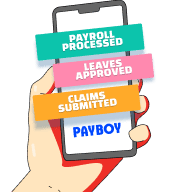Welcome to our comprehensive guide on becoming an effective HR business partner (HRBP). In this guide, we'll explore the multifaceted role of an HRBP, delve into the core responsibilities they undertake, and discover how HRBPs can drive and lead organisational change, overcome common challenges, and leverage technology to elevate HR excellence. Join us on this journey to unlock the key strategies and innovative solutions that empower HRBPs to thrive in today's dynamic workplace landscape!
What is an HR business partner (HRBP)?
An HR business partner (HRBP) is a strategic HR professional who collaborates with business leaders to align HR practices with organisational goals. Evolving from traditional HR roles, HR business partners focus on delivering value, driving change, and contributing to business success.
What are the core responsibilities of an HR business partner?
The core responsibilities of HRBPs involve aligning HR strategies with business objectives. This includes workforce planning, talent management, and ensuring HR practices contribute to organisational success. The role is evolving to become more strategic, emphasising analytics, technology, and a deeper understanding of business operations. HRBPs are now crucial, as they act as advocates for both employees and the organisation.
HRBPs encompass a diverse range of responsibilities within an organisation. Gartner, a leading global management consultancy firm, has delineated four distinct roles that underscore their versatility:
- Strategic Partner: plays a pivotal role in developing and implementing enterprise-wide strategies to tackle significant challenges.
- Operations Manager: responsible for measuring and monitoring existing HR policies and procedures.
- Emergency Responder: provides immediate solutions to acute emergencies as they arise.
- Employee Mediator: facilitates the resolution of individual employee issues by finding mutually beneficial solutions.
How can companies benefit from having HR business partners?
- Strategic Alignment: HR business partners (HRBPs) ensure HR initiatives are aligned with the overall business strategy, fostering a cohesive approach towards achieving organisational goals.
- Talent Management: HRBPs play a crucial role in talent acquisition, development, and retention strategies, ensuring the organisation has the right talent in place to drive success.
- Employee Engagement: HRBPs focus on enhancing employee experiences and engagement, leading to higher job satisfaction, productivity, and retention rates within the organisation.
- Change Management: HRBPs facilitate organisational change by providing guidance, support, and resources to leaders and employees, helping them adapt to new processes, technologies, and initiatives.
- Data-Driven Decision-Making: HRBPs utilise HR analytics and metrics to gather insights into workforce trends, enabling informed decision-making on matters such as recruitment, performance management, and talent development.
7 key metrics and analytics that HR business partners should focus on
HRBPs should be data-driven in their decision-making. The era of HR relying on gut feelings for decision-making has passed. Modern HR business partners are required to adeptly navigate dashboards and decipher reports containing intricate data, allowing them to make informed decisions. Here are some key metrics that HRBP can leverage on, including:
Metric #1: Managing absence rates and costs
Absences can significantly impact productivity and workforce planning. HRBPs play a crucial role in tracking absence rates and associated costs. This enables them to implement policies or programmes to mitigate their impact on operations.
Metric #2: Gauging Employee Net Promoter Score (eNPS)
Serving as a vital link between employees and upper management, HRBPs monitor eNPS to gauge overall employee satisfaction. This metric provides insights to inform leadership decisions and facilitates the initiation of programmes aimed at enhancing morale and engagement across the organisation.
Metric #3: Addressing turnover rates
Retention is a key focus for HRBPs, and high turnover rates can signal issues in management, compensation, or company culture. By closely monitoring turnover rates, HRBPs can implement targeted interventions to enhance retention strategies.
Metric #4: Assessing training effectiveness
Involved in the development and implementation of training programmes, HRBPs monitor the effectiveness of these initiatives. This ensures that training efforts are improving employees' skills, increasing productivity, and aligning with organisational goals.
Metric #5: Measuring training Return on Investment (ROI)
HRBPs are responsible for budgets and demonstrating the business impact of training and development initiatives. By measuring the ROI of training programmes, HRBPs showcase how these investments translate into tangible business outcomes.
Metric #6: Evaluating quality of hire
The quality of hire metric aids HRBPs in assessing the effectiveness of their recruiting strategies. This evaluation helps them make necessary adjustments to ensure they attract talent that positively contributes to the organisation's goals.
Metric #7: Tracking promotion and progression rates
HRBPs actively contribute to fostering an inclusive culture. By tracking promotion and progression rates across different demographic groups, they can identify and address potential systemic inequities, promoting a fair and equitable workplace.
6 tips for HR business partners drive and lead organisational change
Tip #1: Understand the business context
Delving into the organisation's overarching strategy and objectives. By aligning proposed changes with these goals, the relevance and support for the change initiative are fortified.
Tip #2: Engage leadership and stakeholders
Collaborate with top leadership to secure their commitment and active support. Moreover, involve key stakeholders early in the process to gather input and foster ownership of the change.
Tip #3: Foster a change-ready culture
Cultivate a culture that embraces change as a constant and necessary part of growth. Recognise and celebrate small wins to build momentum and reinforce the positive aspects of change.
Tip #4: Address resistance proactively
Anticipate and address resistance by identifying potential concerns early in the process. Create channels for open dialogue and feedback, encouraging employees to voice their concerns.
Tip #5: Monitor and measure progress
Establish key performance indicators (KPIs) to measure the success of the change initiative.
Regularly assess progress, making adjustments as needed to stay on course. Furthermore, be prepared to adjust the strategy based on feedback, changing circumstances, or new insights.
If you're seeking comprehensive guidance on designing an effective performance appraisal system to track progress and ensure alignment with organisational goals, check out our insightful guide on how to design an effective performance appraisal system.
Tip #6: Encourage innovation and agility
Foster a culture of innovation, encouraging teams to propose and implement improvements.
Embrace agile methodologies to respond quickly to evolving business needs.
How to overcome the common challenges that HR business partners face?
HRBPs frequently grapple with recurring challenges such as resistance to change, limited data literacy, and the delicate balance between strategic and operational roles. To address these issues and pave the way for sustained success, HRBPs can adopt a multi-faceted approach:
Foster a culture of adaptability
Conduct regular skills assessments to identify areas for improvement within HR teams. This proactive approach allows HRBPs to target training interventions, enhance data literacy, and promote a culture of continuous learning.
Effective change management
Implement robust change management strategies to address resistance to new initiatives. By cultivating an environment that embraces change, HRBPs can instil confidence and openness among employees, facilitating smoother transitions.
Time and priority management
Balancing the dual roles of strategic visionaries and operational executors requires efficient time and priority management. HRBPs must navigate this challenge by optimising workflows, setting clear priorities, and leveraging technology to enhance operational efficiency.
Mentorship programmes
Establish mentorship programmes within HR teams where seasoned professionals share insights and experiences. This collaborative learning approach contributes to overcoming challenges, fostering continuous improvement, and equipping HR professionals with the skills needed for long-term success
What role does technology play in elevating HR excellence?
Technology plays a pivotal role in enhancing HR excellence by streamlining processes, improving efficiency, and enabling data-driven decision-making. From automated recruitment systems to advanced analytics tools, technology empowers HR professionals to effectively manage talent acquisition, employee engagement, performance evaluation, and more. By leveraging innovative HR software and platforms, organisations can optimise their HR operations, enhance employee experiences, and ultimately drive business success. Keep scrolling to discover innovative solutions waiting for you to embrace.
Here are some examples of HR softwares and tools:
- Applicant Tracking Systems (ATS): ATS software automates the recruitment process by managing job postings, screening resumes, and tracking candidate progress.
- HR Information Systems (HRIS): HRIS platforms centralise employee data, such as payroll information, attendance records, performance evaluations, and training history, streamlining HR tasks.
- Performance Management Software: These tools facilitate goal-setting, feedback collection, and performance evaluations, enabling managers to assess employee performance and provide constructive feedback.
- Learning Management Systems (LMS): LMS platforms deliver and manage employee training and development programmes, offering courses, tracking progress, and assessing learning outcomes.
- Employee Engagement Platforms: These tools measure employee satisfaction, collect feedback, and provide insights to improve workplace culture and boost employee morale.
- Payroll Software: Payroll software automates payroll processing, calculates wages, deducts taxes, and generates payslips, ensuring accurate and timely salary disbursements. Read more
- Time and Attendance Systems: These systems track employee attendance, monitor work hours, and manage leave requests, helping organisations ensure compliance with labour regulations and optimise workforce scheduling.
- Benefits Administration Software: These tools streamline benefits enrolment, manage employee benefits packages, and facilitate communication between HR departments and benefits providers.
- Performance Review Software: Performance review software automates the performance evaluation process, allowing managers to set goals, track progress, and conduct regular performance appraisals.
- Employee Onboarding Software: These platforms streamline the onboarding process by automating paperwork, delivering training materials, and facilitating communication between new hires and HR departments.
Tip: You may find it confusing that HRIS, HCM, and HRMS are terms often used interchangeably to describe HR systems. Head over to our guide on “HRIS, HCM & HRMS: How to choose the right HR system for SMEs” as we provide insights on these different systems and walk you through the process of choosing the one that's the perfect fit for your business!
Equip your HR Business Partners with Payboy HR & Payroll Software to enhance operational efficiency
As a PSG-approved HRMS, Payboy offers a comprehensive suite of modules to streamline HR processes, freeing up valuable time for HRBPs to focus on strategic initiatives.
Tailored to meet the specific needs of modern businesses, our solution includes:
- Payroll Processing: Ensure accuracy and compliance in payroll tasks, empowering HRBPs to navigate complex compensation structures effortlessly.
- Leave Management: Simplify and automate the leave management process to enhance workforce planning and optimise resource allocation.
- Claims Management: Streamline the claims process to ensure transparency and efficiency in handling reimbursement requests.
- Time Attendance: Enhance workforce visibility and punctuality monitoring with a robust time attendance module, aiding HRBPs in effective workforce management.
- Shift Scheduling: Optimise workforce scheduling with a user-friendly module, facilitating efficient planning and management of shifts.
Stay ahead of the curve and equip your HRBPs with the tools they need to drive strategic initiatives, enhance operational efficiency, and navigate the complexities of future challenges!





















